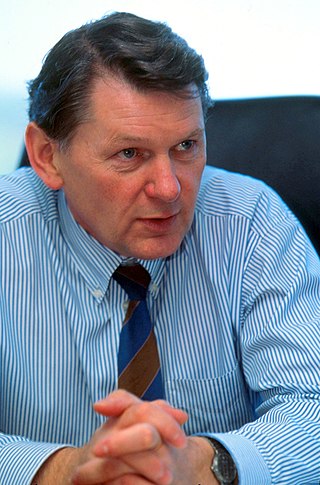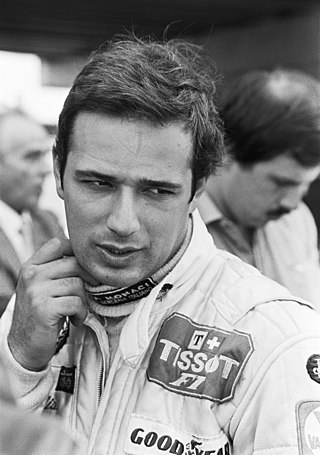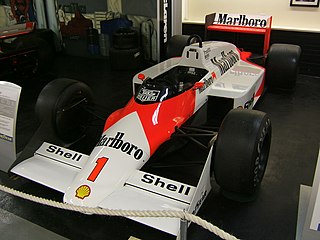Motor Racing Developments Ltd., commonly known as Brabham, was a British racing car manufacturer and Formula One racing team founded in 1960 by Australian driver Jack Brabham and British-Australian designer Ron Tauranac. The team won four FIA Formula One Drivers' and two Constructors' World Championships in its 30-year history, starting out with back-to-back wins of both in 1966 and 1967. Jack Brabham's 1966 Drivers' Championship remains the only such achievement using a car bearing the driver's own name.
McLaren Racing Limited is a British motor racing team based at the McLaren Technology Centre in Woking, Surrey, England. McLaren is best known as a Formula One chassis constructor, the second oldest active team and the second most successful Formula One team after Ferrari, having won 183 races, 12 Drivers' Championships and 8 Constructors' Championships. McLaren also has a history of competing in American open wheel racing, as both an entrant and a chassis constructor, and has won the Canadian-American Challenge Cup (Can-Am) sports car racing championship. The team is a subsidiary of the McLaren Group, which owns a majority of the team.

BMW has been involved in Formula One in a number of capacities since the inauguration of the World Drivers' Championship in 1950. The company entered occasional races in the 1950s and 1960s, before building the BMW M12/13 inline-four turbocharged engine in the 1980s. This engine was the result of a deal between BMW and Brabham, which resulted in the team's chassis being powered by BMW engines from 1982 until 1987, a period in which Nelson Piquet won the 1983 championship driving a Brabham BT52-BMW. BMW also supplied the M12/13 on a customer basis to the ATS, Arrows, Benetton and Ligier teams during this period, with various degrees of success. In 1988, Brabham temporarily withdrew from the sport and BMW withdrew its official backing from the engines, which were still used by the Arrows team under the Megatron badge. Turbocharged engines were banned by the revised Formula One Technical Regulations for 1989, rendering the M12/13 obsolete.

Sir Ronald Dennis is a British businessman and an Official British Business Ambassador for the United Kingdom. He is best known for his former role as owner, CEO, chairman and founder of McLaren Group. Dennis was removed from his McLaren management roles in 2016 but remained a director of the company and a 25-per-cent shareholder until June 2017, when his 37-year association with the company ended.

John Edward Barnard, is an English engineer and racing car designer. Barnard is credited with the introduction of two new designs into Formula One: the carbon fibre composite chassis first seen in 1981 with McLaren, and the semi-automatic gearbox which he introduced with Ferrari in 1989.
McLaren Automotive is a British luxury automotive manufacturer based at the McLaren Technology Centre in Woking, England. The main products of the company are sports cars, which are produced in-house in designated production facilities. In July 2017, McLaren Automotive became a wholly-owned subsidiary of the wider McLaren Group.

Elio de Angelis was an Italian racing driver who participated in Formula One between 1979 and 1986, racing for the Shadow, Lotus and Brabham teams. He was killed in an accident while testing the Brabham BT55 at the Paul Ricard circuit, near the commune of Le Castellet, France, in 1986. De Angelis was a very competitive and highly popular presence in Formula One during the 1980s, and is sometimes referred to as Formula One's "last gentleman player".

Team Lotus was the motorsport sister company of English sports car manufacturer Lotus Cars. The team ran cars in many motorsport categories including Formula One, Formula Two, Formula Ford, Formula Junior, IndyCar, and sports car racing. More than ten years after its last race, Team Lotus remained one of the most successful racing teams of all time, winning seven Formula One Constructors' titles, six Drivers' Championships, and the Indianapolis 500 in the United States between 1962 and 1978. Under the direction of founder and chief designer Colin Chapman, Lotus was responsible for many innovative and experimental developments in critical motorsport, in both technical and commercial arenas.

The Brabham BT46 is a Formula One racing car designed by Gordon Murray for the Brabham team, owned by Bernie Ecclestone, for the 1978 Formula One season. The car featured several radical design elements, one of which was the use of flat panel heat exchangers on the bodywork of the car to replace conventional water and oil radiators. It was removed before the car's race debut, never to be seen again. The cars, powered by a flat-12 Alfa Romeo engine, raced competitively with modified nose-mounted radiators for most of the year, driven by Niki Lauda and John Watson, winning one race in this form and scoring sufficient points for the team to finish third in the constructors' championship.

The Lotus 88 is an innovative Formula One car designed by Colin Chapman, Peter Wright, Tony Rudd and Martin Ogilvie of Lotus in an effort to maximise the downforce produced by ground effect. The Lotus 88 made its debut at the first practice session of the 1981 season opener, the US Grand Prix West at Long Beach. Although the Lotus 88 was not allowed to race, it was the first Formula One car to use a carbon fibre monocoque chassis and debut at a Grand Prix event. The carbon fibre McLaren MP4/1 made its first appearance at the third Grand Prix of the season in Argentina.

The McLaren MP4/2 was a Formula One car produced by McLaren for the 1984 season. An iteration of it, the MP4/2B, was used in the 1985 season, and a slightly updated version, the MP4/2C, raced in the 1986 season for McLaren. It was closely based on the MP4/1E model that was used as a test car, used in the final races of 1983.

The McLaren MP4/5, and its derived sister model, the McLaren MP4/5B, were highly successful Formula One racing cars designed by the McLaren Formula One team based in Woking, England, and powered by Honda's naturally-aspirated RA109E and RA100E V10 engines respectively. The chassis design was led by Neil Oatley, teaming up with Steve Nichols, Pete Weismann, Tim Wright, Bob Bell and Mike Gascoyne. As with the previous designs, Gordon Murray, as Technical Director, had the role of liaising between the drawing office and production. Osamu Goto was the Honda F1 team chief designer for the car's engine.

The McLaren MP4/15 was a Formula One car used by the McLaren-Mercedes team in the 2000 Formula One World Championship. The chassis was designed by Adrian Newey, Steve Nichols, Neil Oatley and Henri Durand with Mario Illien designing the bespoke Ilmor engine. The car proved highly competitive and scored seven victories just like its predecessor the MP4/14, but was narrowly beaten to both the Drivers' and Constructors' championships by the Ferrari F1-2000.

The Brabham BT52 was a Formula One car designed for the Brabham team by longtime Brabham designer Gordon Murray for the 1983 season. The car ran on Michelin tyres and was powered by the BMW M12/13 four-cylinder turbocharged engine, which in 1983 produced a maximum power of approximately 1,280 bhp (950 kW) in qualifying trim, detuned to around 850 bhp (630 kW) for the proper races. Its drivers were 1981 World Champion Nelson Piquet and Riccardo Patrese.

The McLaren MP4/3 was the car with which the McLaren team competed in the 1987 Formula One World Championship. The car was designed under the leadership of long-time McLaren engineer Steve Nichols, in collaboration with Neil Oatley, Gordon Kimball, Tim Wright and Bob Bell. It was also the last McLaren car to be powered by the TAG-Porsche turbo engine that had been introduced in 1983. The car was driven by double World Champion Alain Prost, in his fourth season with the team, and Stefan Johansson, who moved from Ferrari.

The Brabham BT55 was a Formula One racing car designed by Gordon Murray and David North for the Brabham team owned by Bernie Ecclestone. It used a BMW four-cylinder turbocharged engine tilted over on its side to allow a clear supply of air to the rear wing. The car competed during the 1986 Formula One season. It was not successful and its introduction coincided with the end of Brabham's time as a competitive team.

The Brabham BT53 was a Formula One car designed by Gordon Murray for the Brabham team for the 1984 Formula One season and was a development of the BT52 which had carried the team's lead driver Nelson Piquet to the 1983 championship.
Stephen Anderson Nichols is an American engineer who is best known as a car designer for many Formula One teams from the mid-1980s until 2001.

The Brabham BT54 was a Formula One racing car designed by Gordon Murray for the Brabham team for the 1985 Formula One season. The car was powered by the BMW M12 4cyl turbo engine and used Pirelli tyres.

The Brabham BT56 was a Formula One car designed by John Baldwin and Sergio Rinland and raced by the Brabham team in the 1987 Formula One World Championship. It was driven by Andrea de Cesaris, Riccardo Patrese and Stefano Modena; both de Cesaris and Patrese scored a 3rd place driving the BT56.















